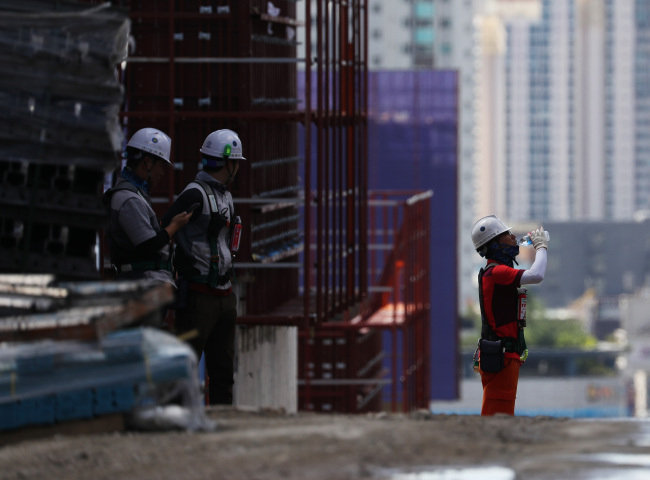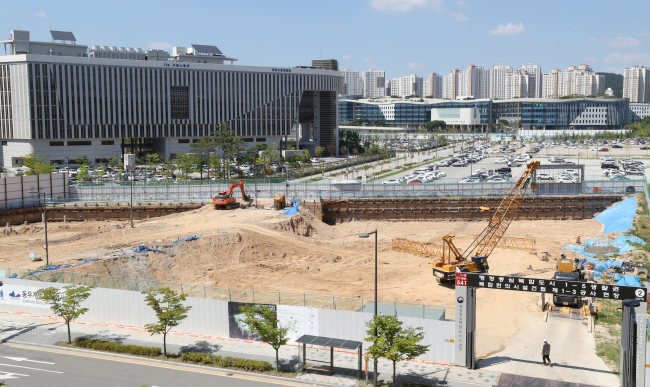Declining construction investment worsens unemployment
By Kim Kyung-hoPublished : Aug. 6, 2018 - 15:19
Weakening construction investment is cited by economists as a key reason for the country’s deteriorating unemployment and decelerating growth.
According to a recent report from the Construction and Economy Research Institute of Korea, the on-year increase in domestic construction investment, which averaged 7.6 percent in 2017, dropped to 1.8 percent in the first quarter of this year and minus 0.7 percent in the following three months.
The number of jobs created by construction investment shrank by 6,638 from a year earlier in the second quarter, compared to an increase of more than 80,000 in the six consecutive quarters from the April-June period of 2016. The increase slowed down to 34,349 in the final quarter of 2017 and 12,093 in the first quarter of 2018.
According to a recent report from the Construction and Economy Research Institute of Korea, the on-year increase in domestic construction investment, which averaged 7.6 percent in 2017, dropped to 1.8 percent in the first quarter of this year and minus 0.7 percent in the following three months.
The number of jobs created by construction investment shrank by 6,638 from a year earlier in the second quarter, compared to an increase of more than 80,000 in the six consecutive quarters from the April-June period of 2016. The increase slowed down to 34,349 in the final quarter of 2017 and 12,093 in the first quarter of 2018.

A study released last month by the Ministry of Employment and Labor showed the number of workers in the construction sector was down 27,000 from the year before to remain at slightly less than 1.32 million in May.
The slump in the construction industry combined with a downturn in facility investment, consumption and exports to decelerate the country’s economic growth to 0.7 percent in the second quarter from 1 percent in the prior quarter.
Announcing its latest economic data last month, the Bank of Korea said construction investment and output contracted 1.3 percent and 2.3 percent on-quarter, respectively, in the April-June period. The reduction in production by local builders was the steepest since the first three months of 2012, when construction output fell 4.7 percent.
According to the central bank’s earlier outlook, construction investment for this year was forecast to record the first annual decrease of 0.2 percent in six years. The contraction was projected to accelerate to minus 2 percent next year.
“The construction industry cannot be expected to grow indefinitely, as it also follows a cycle. The problem is it is contracting too quickly due to government policies, having a significant negative impact on the economy,” said Lee Hong-il, a researcher at the CERIK.
Since President Moon Jae-in’s administration was launched in May last year, local construction firms have been hit by measures to curb rising home prices and reduce fiscal spending on infrastructure.
According to government data, the size of land approved for residential construction in the first half of this year shrank 17.2 percent from a year earlier as the housing market was dampened by a series of steps taken to rein in property prices.
The slump in the construction industry combined with a downturn in facility investment, consumption and exports to decelerate the country’s economic growth to 0.7 percent in the second quarter from 1 percent in the prior quarter.
Announcing its latest economic data last month, the Bank of Korea said construction investment and output contracted 1.3 percent and 2.3 percent on-quarter, respectively, in the April-June period. The reduction in production by local builders was the steepest since the first three months of 2012, when construction output fell 4.7 percent.
According to the central bank’s earlier outlook, construction investment for this year was forecast to record the first annual decrease of 0.2 percent in six years. The contraction was projected to accelerate to minus 2 percent next year.
“The construction industry cannot be expected to grow indefinitely, as it also follows a cycle. The problem is it is contracting too quickly due to government policies, having a significant negative impact on the economy,” said Lee Hong-il, a researcher at the CERIK.
Since President Moon Jae-in’s administration was launched in May last year, local construction firms have been hit by measures to curb rising home prices and reduce fiscal spending on infrastructure.
According to government data, the size of land approved for residential construction in the first half of this year shrank 17.2 percent from a year earlier as the housing market was dampened by a series of steps taken to rein in property prices.

Budget planners have cut expenditures on social overhead capital in the past few years, saying Korea has sufficient SOC stock, or infrastructure. The reduction is set to be made at a far faster pace under the Moon administration, which has been trying to secure funds to implement its lavish welfare and employment programs.
Under a five-year fiscal management scheme worked out in 2016 by the previous government, infrastructure spending was to be cut by an annual average of 6 percent from 26.1 trillion won ($23.2 billion) in 2015 to 18.5 trillion won in 2020.
The Moon administration plans to slash infrastructure spending by 7.5 percent on average annually over the coming years to 16.2 trillion won in 2021.
A recent study by CERIK forecast that a reduction in construction orders this year, which is expected to reach 23.6 trillion won, would lead to cutting the number of employees in the sector by 326,000 over the next five years. It also predicted the infrastructure budget cut planned by the Moon administration would result in shedding another 292,000 jobs over the coming four years.
Experts note a loss of construction jobs tends to leave mostly low-skilled and low-educated workers jobless. They say the Moon administration has ignored the construction industry’s role in shoring up employment, bringing more difficulties to low-income people it has vowed to help.
This contrasts against what is happening in the US, where a booming property market and increased infrastructure spending have combined with massive tax cuts to boost growth and lower unemployment. Korea is set to be outperformed by the world’s largest economy in growth and jobless rates this year for the first time in decades.
“The government needs to readjust curbs on the real estate market and keep the SOC budget at a proper level,” said researcher Lee.
Experts note policymakers should change their passive attitude toward increasing infrastructure spending.
Korea ranks high among members of the Organization for Economic Cooperation and Development in terms of combined length of roads by territory. But its ranking sinks to near the bottom in length per capita and per vehicle.
The planned cut in infrastructure investment also turns a blind eye to the need to refurbish aging roads, bridges and ports around the country. Experts say demand for infrastructure improvement will increase sharply in the coming years as the endurance period of decades-old facilities here comes to an end.
Minister of Economy and Finance Kim Dong-yeon suggested last week the government might reconsider plans to cut infrastructure spending next year following an on-year reduction of 14.2 percent this year.
Signaling a belated shift in policy, Kim told reporters he was having a “forward-looking think” about infrastructure investment, given its effect on regional economies and job stability.
By Kim Kyung-ho
(khkim@heraldcorp.com)
Under a five-year fiscal management scheme worked out in 2016 by the previous government, infrastructure spending was to be cut by an annual average of 6 percent from 26.1 trillion won ($23.2 billion) in 2015 to 18.5 trillion won in 2020.
The Moon administration plans to slash infrastructure spending by 7.5 percent on average annually over the coming years to 16.2 trillion won in 2021.
A recent study by CERIK forecast that a reduction in construction orders this year, which is expected to reach 23.6 trillion won, would lead to cutting the number of employees in the sector by 326,000 over the next five years. It also predicted the infrastructure budget cut planned by the Moon administration would result in shedding another 292,000 jobs over the coming four years.
Experts note a loss of construction jobs tends to leave mostly low-skilled and low-educated workers jobless. They say the Moon administration has ignored the construction industry’s role in shoring up employment, bringing more difficulties to low-income people it has vowed to help.
This contrasts against what is happening in the US, where a booming property market and increased infrastructure spending have combined with massive tax cuts to boost growth and lower unemployment. Korea is set to be outperformed by the world’s largest economy in growth and jobless rates this year for the first time in decades.
“The government needs to readjust curbs on the real estate market and keep the SOC budget at a proper level,” said researcher Lee.
Experts note policymakers should change their passive attitude toward increasing infrastructure spending.
Korea ranks high among members of the Organization for Economic Cooperation and Development in terms of combined length of roads by territory. But its ranking sinks to near the bottom in length per capita and per vehicle.
The planned cut in infrastructure investment also turns a blind eye to the need to refurbish aging roads, bridges and ports around the country. Experts say demand for infrastructure improvement will increase sharply in the coming years as the endurance period of decades-old facilities here comes to an end.
Minister of Economy and Finance Kim Dong-yeon suggested last week the government might reconsider plans to cut infrastructure spending next year following an on-year reduction of 14.2 percent this year.
Signaling a belated shift in policy, Kim told reporters he was having a “forward-looking think” about infrastructure investment, given its effect on regional economies and job stability.
By Kim Kyung-ho
(khkim@heraldcorp.com)








![[Graphic News] More Koreans say they plan long-distance trips this year](http://res.heraldm.com/phpwas/restmb_idxmake.php?idx=644&simg=/content/image/2024/04/17/20240417050828_0.gif&u=)
![[KH Explains] Hyundai's full hybrid edge to pay off amid slow transition to pure EVs](http://res.heraldm.com/phpwas/restmb_idxmake.php?idx=644&simg=/content/image/2024/04/18/20240418050645_0.jpg&u=20240419100350)





![[From the Scene] Monks, Buddhists hail return of remains of Buddhas](http://res.heraldm.com/phpwas/restmb_idxmake.php?idx=652&simg=/content/image/2024/04/19/20240419050617_0.jpg&u=20240419175937)

![[KH Explains] Hyundai's full hybrid edge to pay off amid slow transition to pure EVs](http://res.heraldm.com/phpwas/restmb_idxmake.php?idx=652&simg=/content/image/2024/04/18/20240418050645_0.jpg&u=20240419100350)

![[Today’s K-pop] Illit drops debut single remix](http://res.heraldm.com/phpwas/restmb_idxmake.php?idx=642&simg=/content/image/2024/04/19/20240419050612_0.jpg&u=)